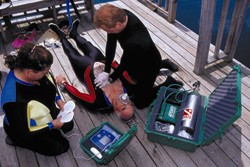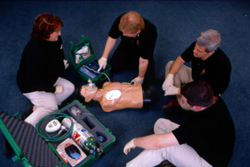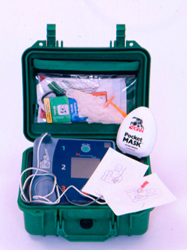|
CLICK HERE TO JOIN DAN 
Intro | Overview | Find Instructor | Teach Course | Related Product
 This course represents
entry-level training designed to educate the general diving
(and qualified non-diving) public to better recognize the
warning signs of Sudden Cardiac Arrest and administer first
aid using Basic Life Support techniques and Automated External
Defibrillators while activating the local emergency medical
services, (EMS) and / or arranging for evacuation to the
nearest appropriate medical facility. This course represents
entry-level training designed to educate the general diving
(and qualified non-diving) public to better recognize the
warning signs of Sudden Cardiac Arrest and administer first
aid using Basic Life Support techniques and Automated External
Defibrillators while activating the local emergency medical
services, (EMS) and / or arranging for evacuation to the
nearest appropriate medical facility.
- The mean age of divers who die each year in dive fatalities
tracked by DAN is gradually increasing. It is now approximately
42 years of age. Divers are getting older, and older people
are getting involved in diving.
- Of the 78 dive fatalities in the DAN 2001 Report on
Decompression Illness, Diving Fatalities and Project Dive
Exploration, based on 1999 fatalities, 7.7 percent of
them were caused directly by heart disease. At the same
time, heart disease was the direct cause of death for
26 percent of the fatalities involving divers over the
age of 35.
- On top of that, 25 percent of divers involved in diving
fatalities were also reported to be taking heart medications.
Heart disease is a common problem. To ignore that it affects
divers as much as it affects the general population does
divers a disservice. When you consider that diving is often
done from remote locations - on beaches or off of dive boats
- that are far removed from emergency medical help, it is
important to prepare for every emergency.
Intro | Overview | Find Instructor | Teach Course | Related Product
 Course Objective Course Objective
This course, DAN Automated External Defibrillators (AEDs)
for Scuba Diving, represents entry-level training designed
to educate the general diving (and qualified non-diving)
public to better recognize the warning signs of Sudden Cardiac
Arrest and administer first aid using Basic Life Support
techniques and Automated External Defibrillators while activating
the local emergency medical services, (EMS) and / or arranging
for evacuation to the nearest appropriate medical facility.
Recommended Minimum Hours of Training
Knowledge Development (Lecture) = 1 Hour
Skills Development (Practice) = 2-3 Hours
It is recommended that this course be taught as a four-hour
module. The time the course actually takes to teach varies
depending upon many factors including the number of students
and their ability to process the educational components
of the program. Instructors desiring to include subjects
or training beyond the course requirements may do so only
before or following the course. Any additional training
must not be required for completion of course requirements.
Learning Objectives
At the end of this program, Automated External Defibrillators
(AEDs) for Scuba Diving course, participants will be able
to:
- Recognize the warning signs of sudden cardiac arrest.
- Provide Basic Life Support while setting up the automated
external defibrillator.
- Provide basic life support with an AED.
- Care for and maintain an AED.
The nature and scope of this course is limited to training
divers and interested non-divers such as boat captains,
water enthusiasts and non-diving family members to provide
emergency cardiac care with an Automated External Defibrillator.
This course does not provide training for cardiopulmonary
resuscitation (CPR) or scuba diving rescue. The training
exercises of this course presuppose that the ill or injured
diver has already been brought to shore or is aboard the
boat.
Participants will complete the written course assessment.
Each student must pass the examination with a score of at
least 80 percent, but the instructor should review the written
assessment with all participants to ensure 100 percent understanding
of the material.
Skill Performance Objectives
To successfully complete the Automated External Defibrillators
(AEDs) for Scuba Diving course, participants must demonstrate
skill and confidence in:
- Providing Basic Life Support.
- Securing and setting up the Automated External Defibrillator.
- Providing care with an Automated External Defibrillator.
Intro | Overview | Find Instructor | Teach Course | Related Product
 The Heartstream FR2
is a portable, lightweight automated external defibrillator
(AED) that requires minimal device training to use and is
an essential part of administering first aid immediately
to a victim of sudden cardiac arrest. Due to its easy-to-use
design, superior technology and affordability, Heartstream
AEDs are now being placed in a wide range of settings such
as hospitals and clinics, offices and industrial locations,
airports and airplanes, health clubs and golf courses. This
innovative AED technology has also enabled a broader range
of people beyond community EMS professionals to provide
lifesaving therapy. The Heartstream FR2
is a portable, lightweight automated external defibrillator
(AED) that requires minimal device training to use and is
an essential part of administering first aid immediately
to a victim of sudden cardiac arrest. Due to its easy-to-use
design, superior technology and affordability, Heartstream
AEDs are now being placed in a wide range of settings such
as hospitals and clinics, offices and industrial locations,
airports and airplanes, health clubs and golf courses. This
innovative AED technology has also enabled a broader range
of people beyond community EMS professionals to provide
lifesaving therapy.
The Heartstream FR2 AED operates with long-life maintenance-free,
lithium manganese batteries, which are designed specifically
for high-volume consumer applications, where safety and
reliability are of the utmost importance. The Heartstream
FR2 performs daily automated self-tests that check readiness
for use. Other features include easy-to-follow voice prompts,
and a bright LCD display to reinforce the voice prompts,
making it easy to use in noisy or dark settings; the FR2
also has enhanced features that can be enabled for improved
hand-off to advanced life support (ALS) responders. Additionally,
the FR2 has on-board training capabilities when used with
the fully rechargeable Training and Administration Pack.
This allows users to safely train on the FR2 using realistic
training scenarios.
The Heartstream FR2 AED incorporates a number of breakthrough
technologies that distinguish it from other AEDs on the
market, including the Philips' low-energy SMART Biphasic
technology. Additionally, the SMART Analysis system automatically
determines if a shock is required and protects against inappropriate
delivery of a shock. This feature eliminates the need for
the operator to be trained in reading and interpreting the
patient's electrocardiogram (ECG).
Contact DAN Training to purchase this
product.
|


 This course represents
entry-level training designed to educate the general diving
(and qualified non-diving) public to better recognize the
warning signs of Sudden Cardiac Arrest and administer first
aid using Basic Life Support techniques and Automated External
Defibrillators while activating the local emergency medical
services, (EMS) and / or arranging for evacuation to the
nearest appropriate medical facility.
This course represents
entry-level training designed to educate the general diving
(and qualified non-diving) public to better recognize the
warning signs of Sudden Cardiac Arrest and administer first
aid using Basic Life Support techniques and Automated External
Defibrillators while activating the local emergency medical
services, (EMS) and / or arranging for evacuation to the
nearest appropriate medical facility.
 Course Objective
Course Objective The Heartstream FR2
is a portable, lightweight automated external defibrillator
(AED) that requires minimal device training to use and is
an essential part of administering first aid immediately
to a victim of sudden cardiac arrest. Due to its easy-to-use
design, superior technology and affordability, Heartstream
AEDs are now being placed in a wide range of settings such
as hospitals and clinics, offices and industrial locations,
airports and airplanes, health clubs and golf courses. This
innovative AED technology has also enabled a broader range
of people beyond community EMS professionals to provide
lifesaving therapy.
The Heartstream FR2
is a portable, lightweight automated external defibrillator
(AED) that requires minimal device training to use and is
an essential part of administering first aid immediately
to a victim of sudden cardiac arrest. Due to its easy-to-use
design, superior technology and affordability, Heartstream
AEDs are now being placed in a wide range of settings such
as hospitals and clinics, offices and industrial locations,
airports and airplanes, health clubs and golf courses. This
innovative AED technology has also enabled a broader range
of people beyond community EMS professionals to provide
lifesaving therapy.